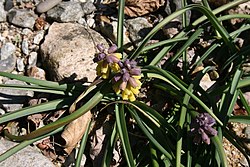| Muscari macrocarpum | |
|---|---|
 | |
| Scientific classification | |
| Kingdom: | Plantae |
| Clade: | Tracheophytes |
| Clade: | Angiosperms |
| Clade: | Monocots |
| Order: | Asparagales |
| Family: | Asparagaceae |
| Subfamily: | Scilloideae |
| Genus: | Muscari |
| Subgenus: | Muscari subg. Muscarimia |
| Species: | M. macrocarpum |
| Binomial name | |
| Muscari macrocarpum Mill. | |
| Synonyms [1] | |
| |
Muscari macrocarpum is a perennial bulbous flowering plant in the asparagus family Asparagaceae. It is one of a number of species known as grape hyacinth, in this case yellow grape hyacinth. [2] Originally from eastern Crete, Amorgos and south-west Turkey, where it grows in rocky places, it is sometimes grown as an ornamental plant. [3]
M. macrocarpum resembles M. racemosum (with which it has been placed in the Muscarimia group of the genus Muscari). It is a robust plant, with large bulbs which have thick fleshy roots. Each bulb produces several greyish-green leaves. Flowers are borne in a spike or raceme on a stem 10–15 cm (3.9–5.9 in) high. Individual flowers may be over 1 cm long, violet in bud and yellow when fully open; they have a distinct scent resembling bananas. [3] Cultivars include 'Golden Fragrance'.